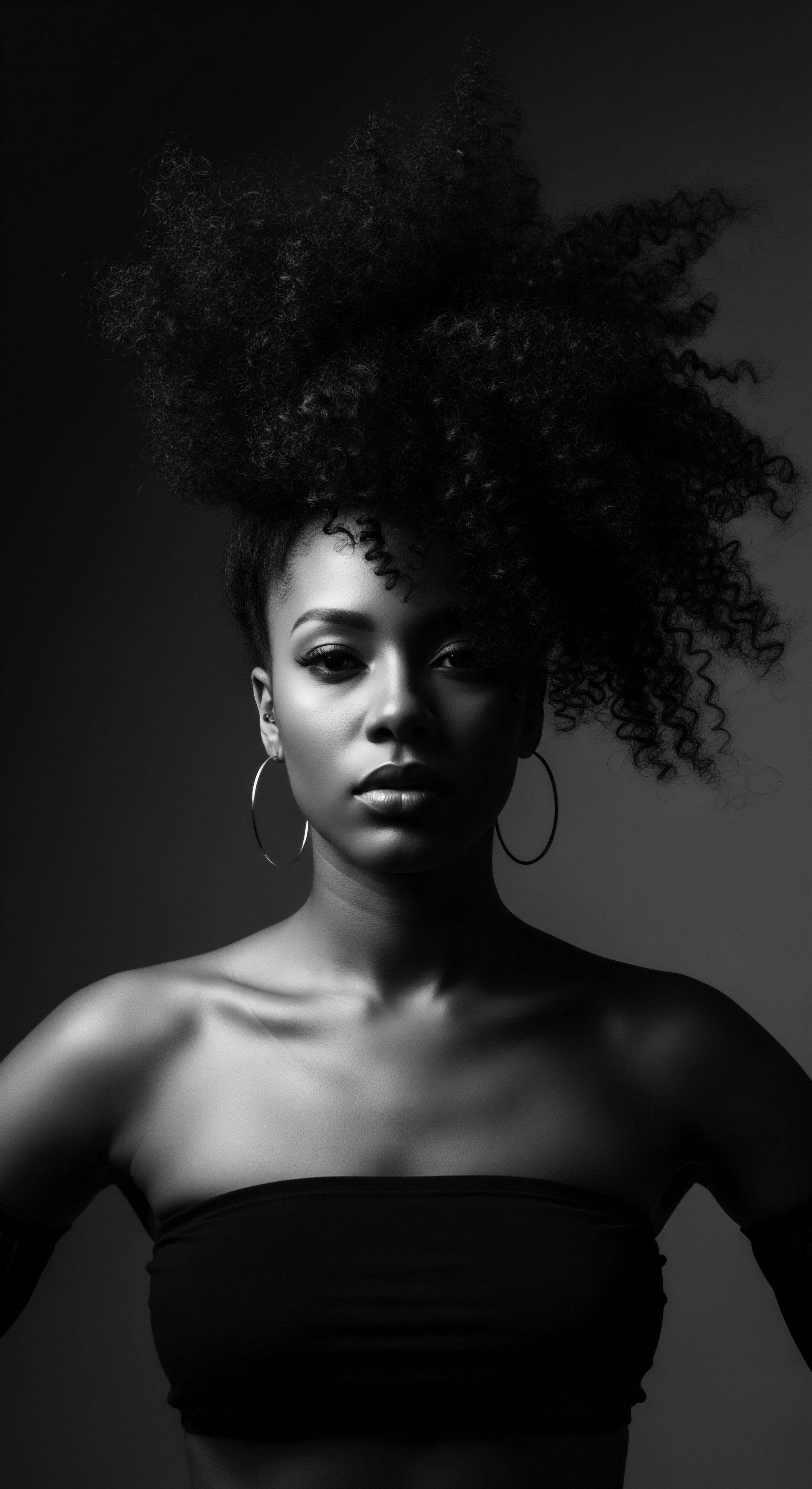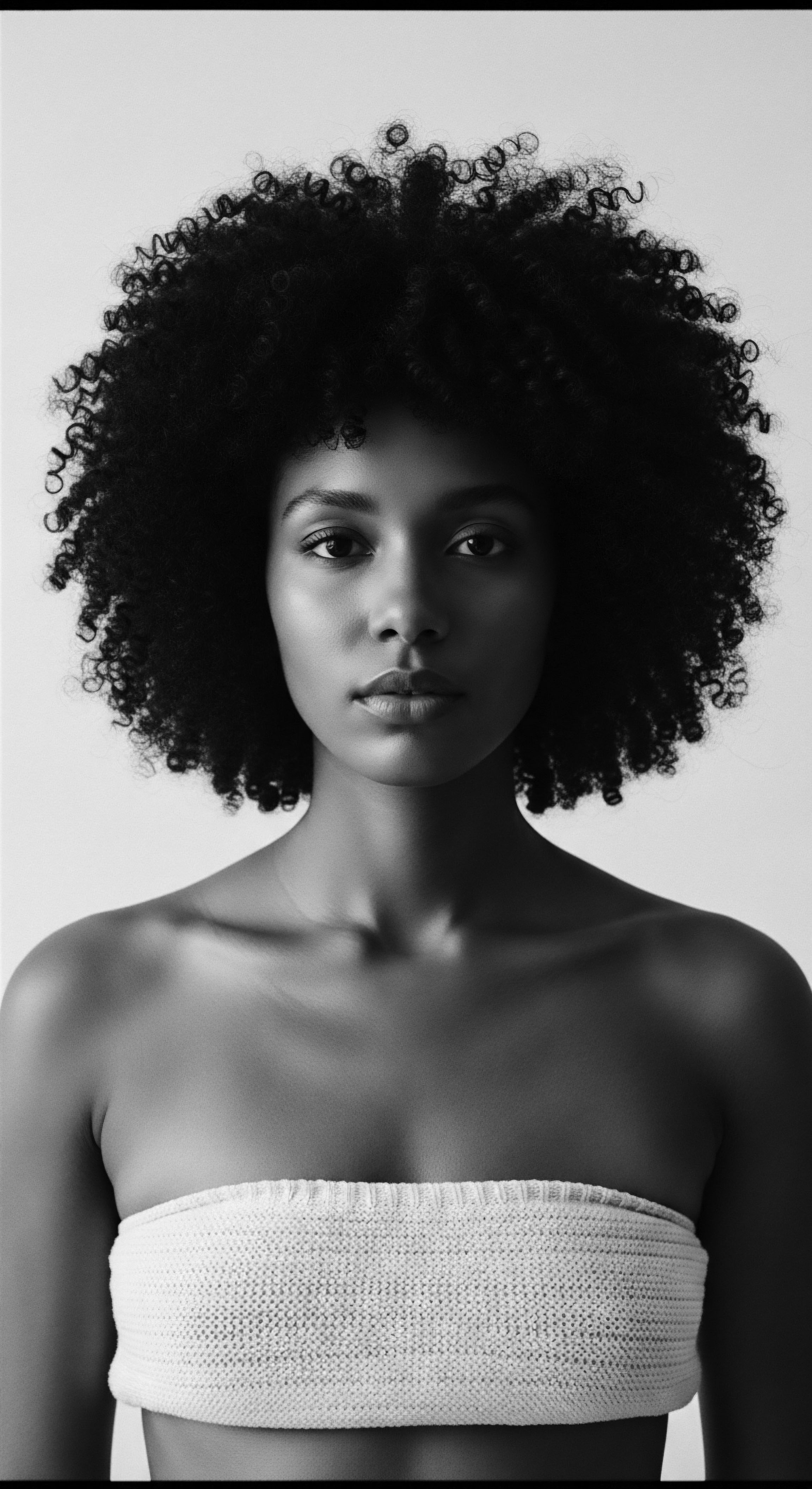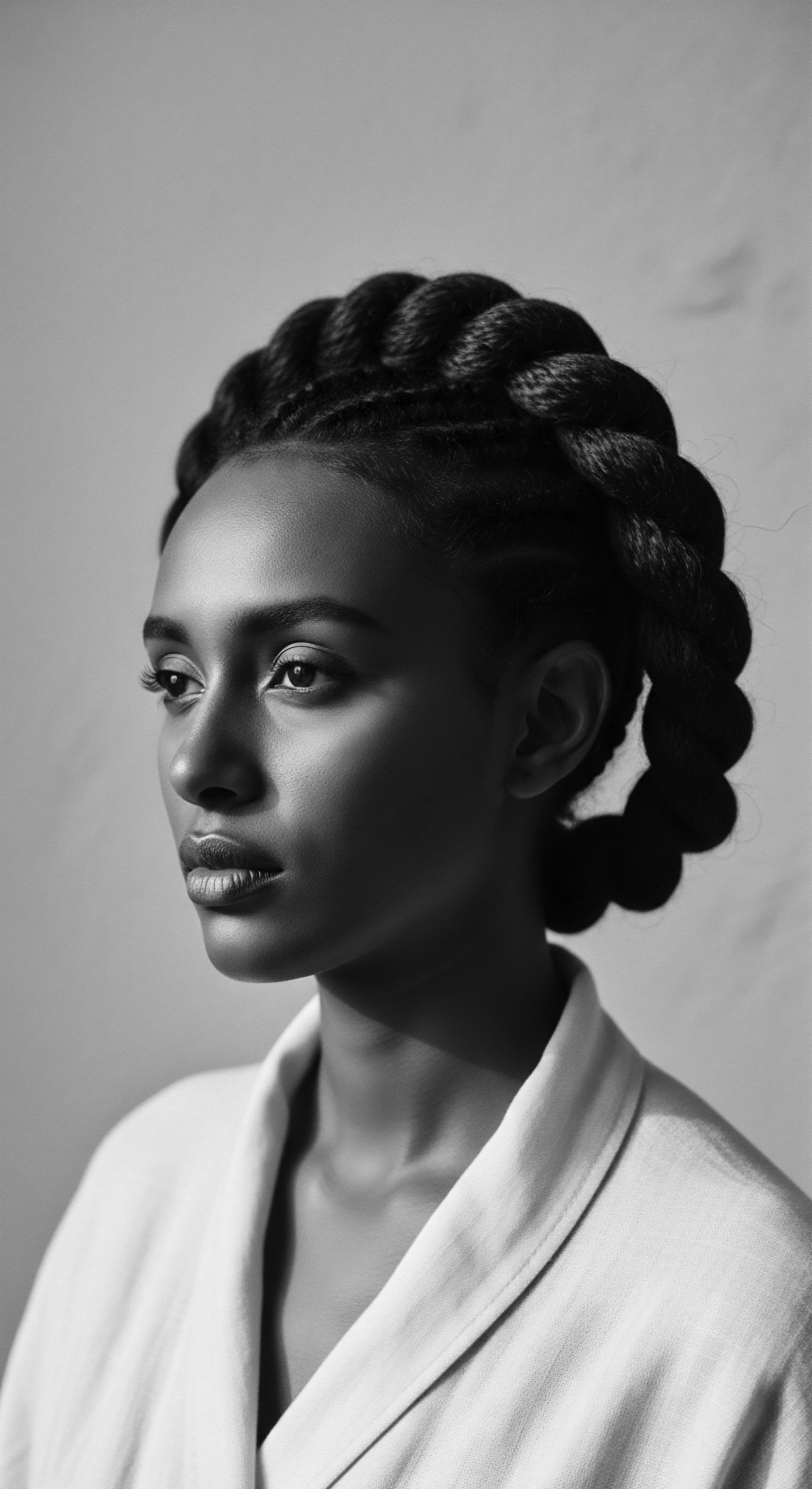
Roots
Consider the resilient strands that crown our heads, each helix a testament to time, survival, and the wisdom carried across generations. Textured hair, in its myriad forms, holds more than just genetic codes; it carries the echoes of ancestral resilience, cultural practices, and the profound connection to the Earth that nourished those who came before us. This is not simply a discussion of diet and its biological impact on keratin.
It is an exploration of how the sustenance our forebears drew from their lands, their seas, and their communal harvests directly shaped the vitality and very integrity of their hair, speaking volumes about their overall wellbeing. We uncover a legacy where food served as both medicine and a profound link to identity.
The very structure of textured hair, with its unique curl patterns and natural inclinations, requires specific nutritional support. From the outermost cuticle layer to the innermost medulla, each component relies upon a steady stream of building blocks. Ancestral foodways, often dictated by geography, climate, and the ingenuity of cultivation, provided precisely these vital elements. Early human populations, particularly those in equatorial Africa, developed tightly coiled hair, which offered significant protection from intense solar radiation and aided in cooling, allowing for brain expansion.
(Jablonski, 2023). This natural adaptation suggests a long-standing interplay between environment, physiology, and the very form of our hair.

Hair Anatomy And Ancestral Nutrition
At its core, hair is primarily protein, mainly keratin. The foundational strength, flexibility, and overall health of each strand depend on a steady supply of this building material, derived directly from the foods we consume. Imagine the early diets of West Africa, rich in diverse protein sources from legumes like black-eyed peas and groundnuts, or the fish abundant in coastal communities. These were not random choices; they represented a deep understanding, passed down through oral traditions, of what truly sustains life, right down to the hair on one’s head.
- Protein ❉ Essential for keratin synthesis, found in beans, lentils, fish, and certain indigenous meats.
- Fats ❉ Healthy lipids, particularly monounsaturated and omega fatty acids, maintain scalp health and hair moisture, often sourced from avocados, palm oil, and various seeds.
- Minerals ❉ Iron, zinc, and selenium are vital for oxygen transport to follicles, cell growth, and antioxidant protection, present in leafy greens and organ meats.
- Vitamins ❉ A diverse range of vitamins, including B-complex, C, D, and E, support everything from collagen production to sebum regulation and cellular turnover within hair follicles.

Understanding Our Textured Hair Classifications
Modern systems classify textured hair by curl pattern, ranging from waves to tightly coiled strands. While these classifications offer a framework for understanding care needs, a deeper, historical view reveals that such distinctions held far more than aesthetic meaning. Within many ancestral communities, hair texture spoke to lineage, marital status, age, and spiritual connection. The way hair behaved, its strength, its ability to hold styles, directly influenced these markers.
A diet that promoted robust, resilient hair thus served a communal purpose, supporting cultural identity and expression. The very words used in traditional contexts to describe hair often went beyond simple curl types, speaking to the hair’s sheen, its softness, its fullness – qualities that ancestral foods undeniably supported.
Ancestral diets provided the essential nutritional blueprints for the robust health and unique beauty of textured hair.

How Did Ancestral Foods Build Hair Strength?
The resilience of hair, its ability to resist breakage and maintain its structure, is directly tied to the availability of specific micronutrients. For instance, the high iron content in dark leafy greens common in many African and diasporic foodways, such as spinach or collard greens, played a critical part in delivering oxygen to hair follicles, a fundamental process for strong growth (DatelineHealth Africa, 2025). Similarly, the widespread consumption of various beans offered not just protein but also zinc, a mineral vital for tissue growth and repair, which includes the hair follicle itself (Rennora Beauty, 2025). These dietary patterns were not accidental; they were generations of accumulated wisdom.

Ritual
The journey of ancestral foods for hair integrity extends far beyond mere consumption; it unfolds as a ritual, a thoughtful engagement with nature’s bounty that became deeply ingrained in daily life and communal identity. These practices were not divorced from the body’s overall wellbeing, but rather saw hair health as a reflection of inner vitality. From the cultivation of specific plants to the preparation of meals, each step was a conscious act of nourishment, a tender thread woven into the fabric of daily existence.
Consider the meticulous preparation of traditional African or Caribbean dishes. The slow simmering of stews rich with root vegetables, legumes, and nutrient-dense greens not only enhanced flavor but also increased the bioavailability of vitamins and minerals. The addition of healthy fats, such as those from palm oil or coconuts, provided a rich source of fat-soluble vitamins and fatty acids vital for healthy hair and scalp. These food preparation methods, often communal, transformed sustenance into a shared experience, reinforcing cultural bonds alongside physical nourishment.

Traditional Food Preparations for Hair Vitality?
The wisdom of ancestral food preparation often mirrored an intuitive understanding of nutritional synergy. Cooking methods like fermentation, seen in various African and Caribbean traditions, did more than preserve food; they increased the digestibility of nutrients and enhanced beneficial bacterial growth in the gut, which in turn influences systemic health, including the health of hair. When foods were consumed, they were part of a larger ecosystem of care. For example, the incorporation of nutrient-dense ingredients in a staple dish meant that a single meal could contribute to various aspects of wellbeing, from energy levels to the sheen of hair.
Beyond direct consumption, some ancestral foods and plants found dual applications, integrated into topical hair treatments. Aloe vera, common in Caribbean traditions, served as both an internal tonic and an external soothing gel for the scalp, promoting growth and easing irritation (Seabourn, 2019). Similarly, certain oils derived from foods, such as avocado butter or batana oil (from the American palm tree), were applied directly to the hair and scalp, providing moisture and strength from the outside in (Lemon8, 2025). This holistic approach recognized that true hair health blossomed from an inside-out and outside-in continuum of care.
| Ancestral Food Source Aloe Vera |
| Traditional Internal Use Tonic for respiratory ailments, digestive cleansing. |
| Traditional External Hair Use Soothing scalp, easing dandruff, strengthening strands, encouraging growth. |
| Ancestral Food Source Avocado |
| Traditional Internal Use Rich in healthy fats and vitamins for overall wellbeing. |
| Traditional External Hair Use Applied as butter or oil for deep moisture, elasticity, and anti-inflammatory benefits to scalp. |
| Ancestral Food Source Hibiscus |
| Traditional Internal Use Herbal teas for antioxidants. |
| Traditional External Hair Use Paste for softening hair, nourishing scalp, promoting moisture retention. |
| Ancestral Food Source Palm Oil (Batana) |
| Traditional Internal Use Cooking oil, source of nutrients. |
| Traditional External Hair Use Deeply moisturizes hair, improves elasticity, prevents split ends. |
| Ancestral Food Source These examples highlight how ancestral communities intertwined nutrition and topical treatments, recognizing the interconnectedness of internal and external health. |

How Did Ancestral Foodways Influence Hair Rituals?
The deep connection between food and hair became particularly poignant during times of profound disruption. A striking instance of this ancestral wisdom and resilience can be found in the harrowing journeys of the transatlantic slave trade. As enslaved Africans were forcibly taken from their homelands, many women meticulously braided precious seeds—including those of rice, okra, kidney beans, and millet—into their hair before being forced onto ships (Fields-Black, 2007, cited in Black Farmers, 2022). This act was more than a gesture of hope; it was a strategic effort to preserve not just sustenance, but an entire agricultural heritage.
Their hair became a living ark, carrying the botanical future of foodways that would sustain communities and, in turn, contribute to the physical wellbeing and even the textured hair health of their descendants in new lands. This singular historical example powerfully illustrates how food, hair, and survival became inseparable in the collective memory and ongoing heritage of Black and mixed-race experiences.
The preparation and thoughtful consumption of traditional foods formed an ancestral ritual, nourishing the body and extending care to the hair.
This conscious preservation of seeds in hair speaks volumes about the holistic worldview of these communities, where food was a lifeline, a cultural anchor, and a component of physical sustenance that would indirectly, yet surely, support their physical form, including the integrity of their hair. The memory of this practice, whether conscious or unconscious, has informed generations of reverence for natural ingredients and the power of botanicals in Black hair care traditions.

Relay
To truly grasp the legacy of ancestral foods and their effect on textured hair, we must delve into the intricate interplay of biological mechanisms and cultural contexts, recognizing how ancient wisdom often aligned with, and sometimes anticipated, modern scientific understanding. This section bridges the timeless practices with contemporary findings, drawing a clear line from historical diets to the cellular health of hair follicles today. It examines how centuries of foodways, refined through experience and adaptation, cultivated a resilience that speaks volumes about heritage.
The dietary patterns of ancestral communities, particularly those of African and diasporic groups, were characteristically rich in whole, unprocessed foods. These diets often featured a symphony of leafy greens, root vegetables, diverse legumes, and lean protein sources, either from traditional animal husbandry or abundant seafood. This inherent nutritional density provided a steady supply of vitamins, minerals, and amino acids, all critical for the highly metabolic activity of hair follicles.

How Does Modern Science Affirm Ancestral Diets for Hair?
Modern nutritional science validates the efficacy of these historical foodways. Take, for instance, iron. Iron deficiency anemia remains a leading cause of hair thinning and loss worldwide (Clinic Hunter, 2025). Ancestral African diets, with their generous inclusion of spinach, amaranth, and other dark leafy greens, along with various beans and fish, provided readily available sources of iron, ensuring robust hemoglobin production (DatelineHealth Africa, 2025).
Hemoglobin, in turn, is responsible for oxygen transport to all cells, including the rapidly dividing cells of the hair follicle. A consistent supply of oxygen allows these cells to function optimally, producing strong, healthy hair shafts.
Beyond iron, the ancestral intake of Omega-3 fatty acids, abundant in certain fish and seeds, played a role in scalp health. These fatty acids possess properties that soothe inflammation, a common underlying factor in various scalp conditions that impede hair growth (DatelineHealth Africa, 2025). Antioxidants from brightly colored fruits and vegetables, like those found in traditional Caribbean and West African diets, safeguarded hair follicles from oxidative stress, a process that can accelerate aging and damage hair structure (Rennora Beauty, 2025).
The profound wisdom of ancestral foodways often aligns with modern science, revealing the deep efficacy of traditional diets for hair health.

Connecting Foodways to Hair Structure Resilience
The specific protein requirements for textured hair, with its unique helical structure and propensity for dryness, found remarkable support in ancestral food patterns. Collagen, a protein that forms the matrix around hair follicles and contributes to hair strength, relies on Vitamin C for its synthesis (DatelineHealth Africa, 2025). Foods like citrus fruits and sweet peppers, while perhaps not traditionally central to every ancestral diet, were consumed in various forms or alternatives that supplied this vital nutrient. The consistent consumption of diverse protein sources ensured the availability of amino acids, the building blocks of keratin, which directly impacts the integrity and elasticity of textured strands (Medical News Today, 2019).
| Nutrient Iron |
| Ancestral Food Source Examples Leafy greens, lentils, beans, certain meats. |
| Hair Benefit Oxygen transport to follicles, stronger hair growth. |
| Nutrient Protein (Amino Acids) |
| Ancestral Food Source Examples Beans, fish, eggs, millet, sorghum. |
| Hair Benefit Keratin production, hair strength and elasticity. |
| Nutrient Omega-3 Fatty Acids |
| Ancestral Food Source Examples Fatty fish, groundnuts, seeds like sesame. |
| Hair Benefit Scalp health, anti-inflammation, hair shine. |
| Nutrient Zinc |
| Ancestral Food Source Examples Beans, sunflower seeds, oysters. |
| Hair Benefit Hair tissue growth and repair. |
| Nutrient Vitamin C |
| Ancestral Food Source Examples Citrus fruits, sweet peppers, many fruits/vegetables. |
| Hair Benefit Collagen synthesis, iron absorption, antioxidant. |
| Nutrient This table illustrates the targeted nutritional support for hair health inherent in ancestral eating patterns, reflecting a deep, lived understanding of well-being. |

How Did Colonial Impacts Affect Hair Health?
The disruptions brought by colonization profoundly altered ancestral foodways, leading to shifts from nutrient-dense, locally sourced diets to reliance on imported, processed, and often nutritionally inferior foods (YES! Magazine, 2021). This dietary transition had measurable effects on the health of diasporic communities, including their hair. The decrease in consumption of traditional, protein-rich legumes and iron-rich greens, coupled with an increase in refined sugars and fats, contributed to widespread nutritional deficiencies.
Such deficiencies often manifested in diminished hair integrity ❉ weaker strands, increased breakage, and slower growth, a tangible loss reflecting a broader disconnect from heritage food practices. The movement towards food sovereignty in contemporary Black and Indigenous communities directly addresses this historical imbalance, aiming to reclaim control over food systems and re-establish access to traditional, health-promoting foods (Nubian Tigers Podcast, 2025). This re-connection is not simply about sustenance; it is about reclaiming the very elements that historically underpinned strength and identity, including the radiant health of textured hair.

Reflection
The journey through ancestral foodways and their profound relationship with textured hair integrity offers more than a historical lesson; it provides a guiding light for our present and future. It speaks to the enduring wisdom held within our genetic memory and the very fibers of our hair. The ‘Soul of a Strand’ ethos reminds us that each curl, coil, and wave carries stories – stories of survival, of adaptation, and of the Earth’s unwavering generosity. By reconnecting with the dietary practices of our ancestors, we do more than nourish our bodies; we honor a legacy, reclaim a part of ourselves, and forge a path towards holistic wellbeing that extends beyond the purely physical.
The radiant hair that flourished under the care of traditional diets serves as a living archive, beckoning us to listen to its ancient whispers. It beckons us to look to the land, to the heritage of cultivation, and to the communal tables where food was medicine, joy, and a celebration of life. In this rediscovery, we find not only the ingredients for healthier hair but also the deeper connections to culture, community, and the inherent beauty of our textured heritage. This enduring wisdom, passed down through generations, continues to shape our understanding of true beauty, a beauty that begins from within and shines brightly outwards.

References
- Jablonski, N. G. (2023). Evolutionary Role of Curly Hair ❉ Keeping Early Humans Cool and Hydrated. SciTechDaily.
- One Eleuthera Foundation. (2025). Bush Medicine ❉ A Culture-rich Treasure Trove Of Healing Power.
- AfroDeity. (2013). Caribbean Beauty ❉ More Jamaican Healing Plants.
- Lemon8. (2025). Enhance Hair Growth Naturally with Caribbean Bush Medicine Oil.
- Clinic Hunter. (2025). Anemia and Its Impact on Hair ❉ Recognizing Warning Signs and Finding Remedies.
- African Food Network. (Undated). Here are 10 Magical Foods For Hair Growth.
- My Sasun. (2024). African Foods for Healthy Skin and Hair.
- DatelineHealth Africa. (2025). Top 10 African foods for healthy hair.
- Medical News Today. (2019). What are the best foods for healthy hair growth?
- Rennora Beauty. (2025). Foods That Promote Healthy Hair Growth in Black Adults.
- YES! Magazine. (2021). The Unsung Caribbean Roots of the Vegan Food Movement.
- Nubian Tigers Podcast. (2025). Resources For Sustaining Black Food Sovereignty.
- Fields-Black, E. L. (2007). Deep Roots ❉ Rice Farmers in West Africa and the Americas. Indiana University Press. (Cited in Black Farmers, 2022, “From Slavery to Sovereignty ❉ The Economic Importance of the Justice for Black Farmers Act”)
